Satas D., Tracton A.A. (ed.). Coatings Technology Handbook
Подождите немного. Документ загружается.

This Page Intentionally Left Blank
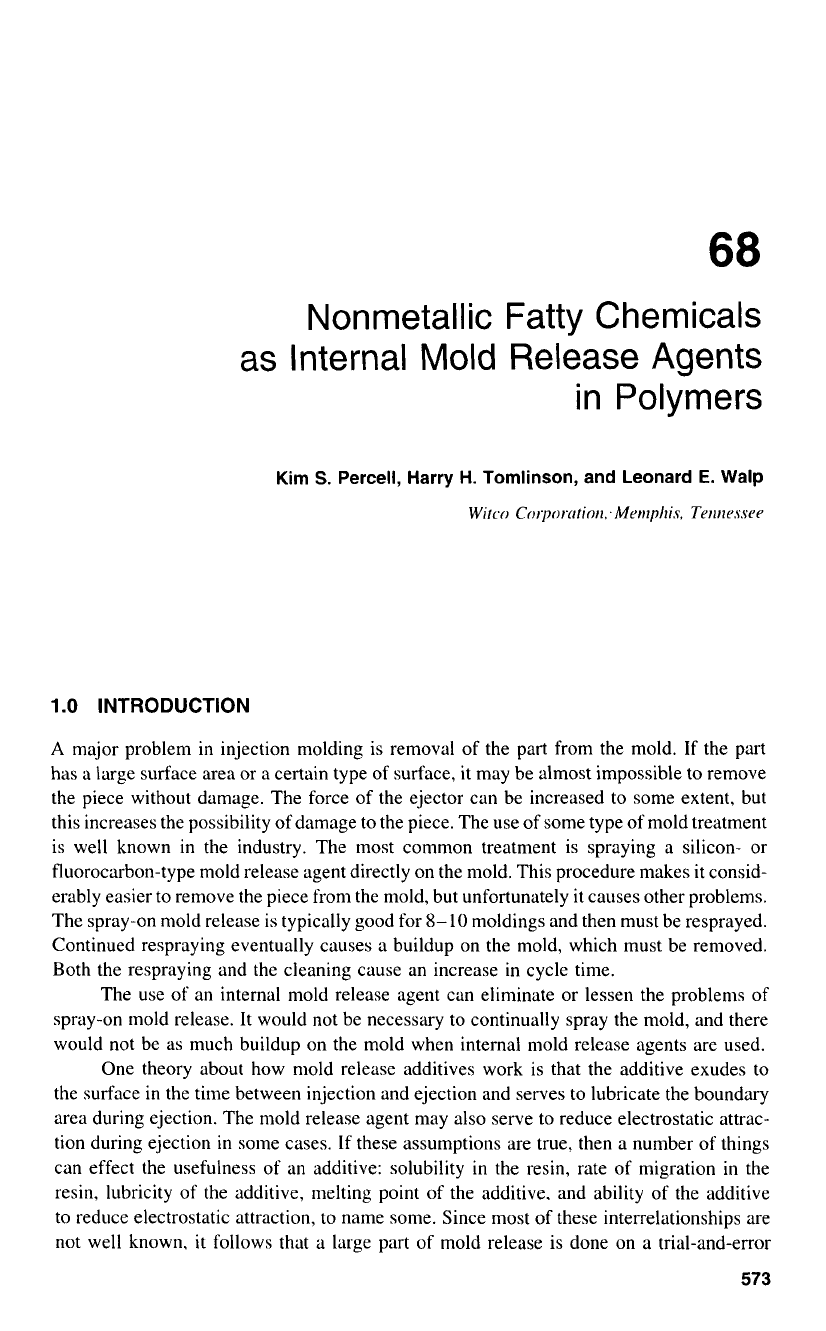
Nonmetallic Fatty Chemicals
as Internal
Mold
Release Agents
in Polymers
Kim
S.
Percell, Harry H. Tomlinson, and Leonard E. Walp
Wilco
Corpor.crtiorl;Menzphis,
Terrrlessee
1
.O
INTRODUCTION
A
major problem in injection molding is removal of the part from the mold.
If
the part
has a large surface area
or
a certain type of surface, it may be almost impossible to remove
the piece without damage. The force
of
the ejector can be increased
to
some extent, but
this increases the possibility of damage
to
the piece. The use
of
some type of mold treatment
is well known in the industry. The most common treatment is spraying a silicon- or
fluorocarbon-type mold release agent directly
on
the mold. This procedure makes it consid-
erably easier
to
remove the piece from the mold, but unfortunately it causes other problems.
The spray-on mold release is typically good for
8-
10
moldings and then must be resprayed.
Continued respraying eventually causes
a
buildup on the mold, which must be removed.
Both the respraying and the cleaning cause an increase in cycle time.
The use of an internal mold release agent can eliminate or lessen the problems
of
spray-on mold release. It would not be necessary to continually spray the mold, and there
would not be as much buildup on the mold when internal mold release agents are used.
One theory about how mold release additives work is that the additive exudes
to
the surface
in
the time between injection and ejection and serves to lubricate the boundary
area during ejection. The mold release agent may also serve to reduce electrostatic attrac-
tion
during ejection in some cases. If these assumptions are true, then a number
of
things
can effect the usefulness
of
an additive: solubility in the resin, rate of migration
in
the
resin, lubricity
of
the additive, melting point
of
the additive. and ability of the additive
to reduce electrostatic attraction, to name some. Since most
of
these interrelationships are
not well known. it follows that a large part of mold release is done on a trial-and-error
573
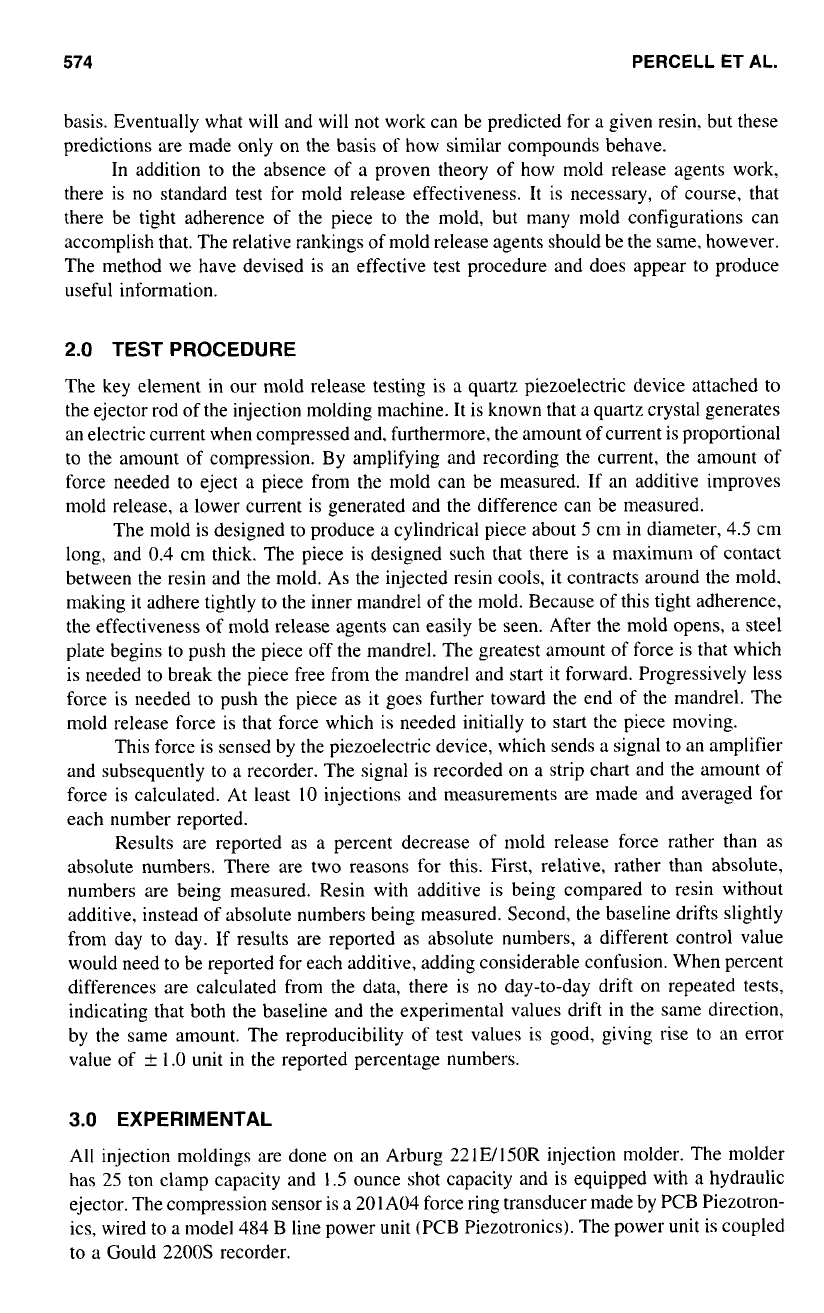
574
PERCELL
ET
AL.
basis. Eventually what will and will not work can be predicted for a given resin. but these
predictions are made only on the basis of how similar compounds behave.
In addition to the absence of a proven theory of how mold release agents work.
there is no standard test for mold release effectiveness. It is necessary,
of
course, that
there be tight adherence
of
the piece
to
the mold, but many mold configurations can
accomplish that. The relative rankings of mold release agents should be the same, however.
The method we have devised is an effective test procedure and does appear to produce
useful information.
2.0
TEST PROCEDURE
The key element in our mold release testing is
a
quartz piezoelectric device attached
to
the ejector rod of the injection molding machine. It is known that
a
quartz crystal generates
an electric cument when compressed and. furthermore, the amount of current is proportional
to the amount of compression. By amplifying and recording the current, the amount of
force needed to eject
a
piece from the mold can be measured. If an additive improves
mold release,
a
lower current is generated and the difference can be measured.
The mold is designed to produce a cylindrical piece about
5
cm in diameter,
4.5
cm
long, and
0.4
cm thick. The piece is designed such that there is a maximum
of
contact
between the resin and the mold. As the injected resin cools,
it
contracts around the mold.
making
it
adhere tightly
to
the inner mandrel
of
the mold. Because of this tight adherence,
the effectiveness of mold release agents can easily be seen. After the mold opens, a steel
plate begins to push the piece off the mandrel. The greatest amount
of
force is that which
is needed to break the piece free from the mandrel and start
it
forward. Progressively less
force is needed to push the piece
as
it goes further toward the end of the mandrel. The
mold release force is that force which is needed initially to start the piece moving.
This force is sensed by the piezoelectric device, which sends
a
signal to an amplifier
and subsequently
to
a
recorder. The signal is recorded on a strip chart and the amount
of
force is calculated. At least
10
injections and measurements are made and averaged for
each number reported.
Results are reported as a percent decrease
of
mold release force rather than
as
absolute numbers. There are two reasons for this. First, relative, rather than absolute,
numbers are being measured. Resin with additive is being compared
to
resin without
additive, instead of absolute numbers being measured. Second, the baseline drifts slightly
from day to day. If results are reported as absolute numbers, a different control value
would need to be reported for each additive, adding considerable confusion. When percent
differences are calculated from the data, there is
no
day-to-day drift on repeated tests,
indicating that both the baseline and the experimental values drift in the same direction,
by the same amount. The reproducibility of test values is good, giving rise
to
an error
value of
t
1.0
unit in the reported percentage numbers.
3.0
EXPERIMENTAL
All injection moldings are done on an Arburg 221E/150R injection molder. The molder
has
25
ton clamp capacity and
1.5
ounce shot capacity and is equipped with a hydraulic
ejector. The compression sensor is a 201A04 force ring transducer made by PCB Piezotron-
ics, wired
to
a model
484
B line power unit (PCB Piezotronics). The power unit is coupled
to a Gould
2200s
recorder.
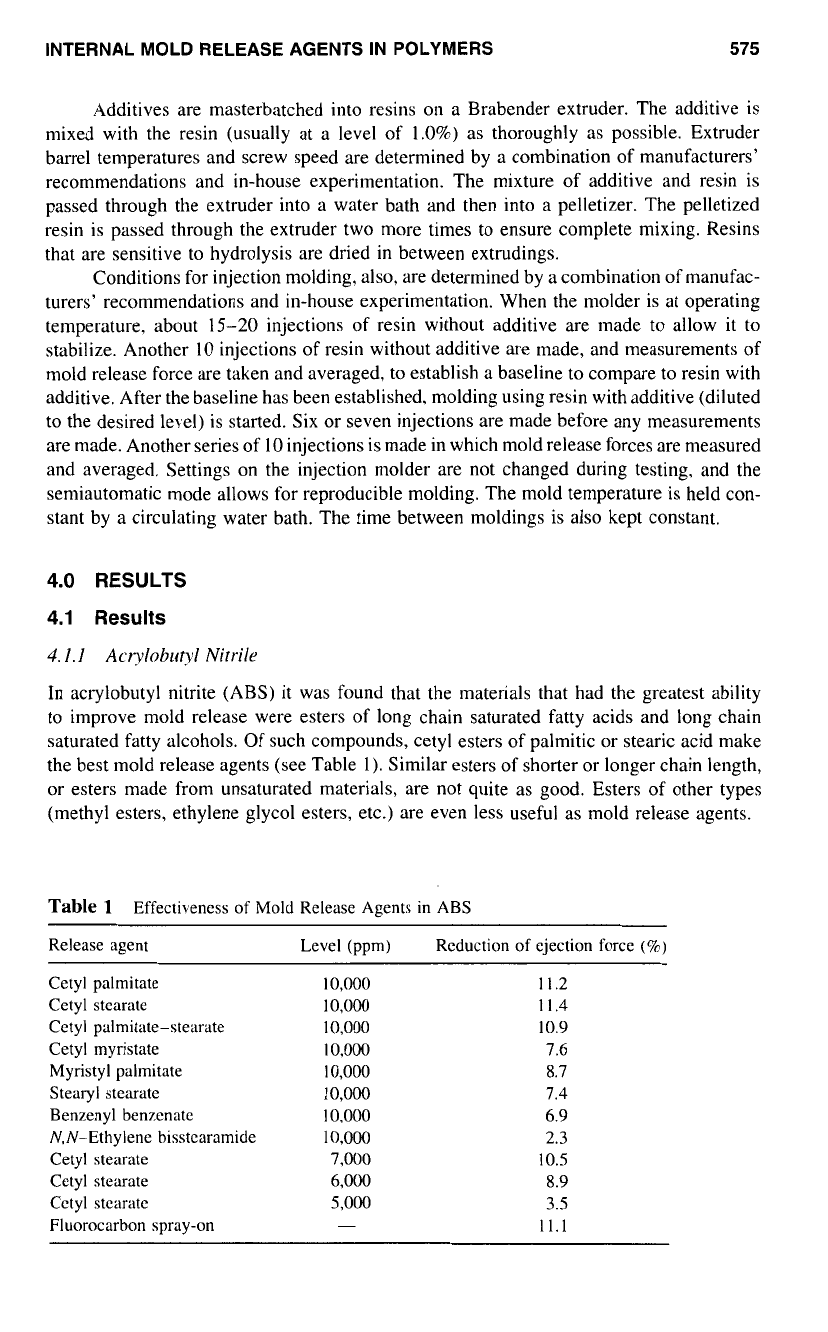
INTERNAL MOLD RELEASE AGENTS IN POLYMERS
575
Additives are masterbatched into resins
on
a
Brabender extruder. The additive is
mixed with the resin (usually at
a
level of
1.0%)
as
thoroughly as possible. Extruder
barrel temperatures and screw speed are determined by
a
combination of manufacturers’
recommendations and in-house experimentation. The mixture
of
additive and resin is
passed through the extruder into
a
water bath and then into
a
pelletizer. The pelletized
resin is passed through the extruder two more times to ensure complete mixing. Resins
that are sensitive to hydrolysis are dried in between extrudings.
Conditions for injection molding,
also,
are determined by a combination of manufac-
turers’ recommendations and in-house experimentation. When the molder is at operating
temperature, about
15-20
injections of resin without additive are made
to
allow it
to
stabilize. Another
10
injections of resin without additive are made, and measurements of
mold release force are taken and averaged, to establish
a
baseline to compare to resin with
additive. After the baseline has been established, molding using resin with additive (diluted
to the desired level) is started. Six or seven injections are made before any measurements
are made. Another series of
IO
injections is made in which mold release forces are measured
and averaged. Settings on the injection molder are not changed during testing, and the
semiautomatic mode allows for reproducible molding. The mold temperature is held con-
stant by
a
circulating water bath. The time between moldings is also kept constant.
4.0
RESULTS
4.1
Results
4.
l.
l
Acryloblrtyl
Nitrile
In acrylobutyl nitrite (ABS) it was found that the materials that had the greatest ability
to improve mold release were esters of long chain saturated fatty acids and long chain
saturated fatty alcohols. Of such compounds, cetyl esters
of
palmitic or stearic acid make
the best mold release agents (see Table
1).
Similar esters of shorter or longer chain length,
or esters made from unsaturated materials, are not quite
as
good. Esters
of
other types
(methyl esters, ethylene glycol esters, etc.) are even less useful
as
mold release agents.
Table
1
Effectiveness of Mold Release Agents in
ABS
Release agent Level (ppm) Reduction of ejection force
(%)
Cetyl palmitate
Cetyl stearate
Cetyl palmitate-stearate
Cetyl myristate
Myristyl palmitate
Benzenyl benzenate
N,N-Ethylene bisstcaramide
Cetyl stearate
Cetyl stearate
Cetyl stearate
Fluorocarbon spray-on
Stearyl stearate
10,000
lO,O00
10,000
10,000
I0,OOO
10,000
10.000
10,000
7,000
6,000
5,000
-
11.2
11.4
10.9
7.6
8.7
7.4
6.9
2.3
10.5
8.9
3.5
11.1
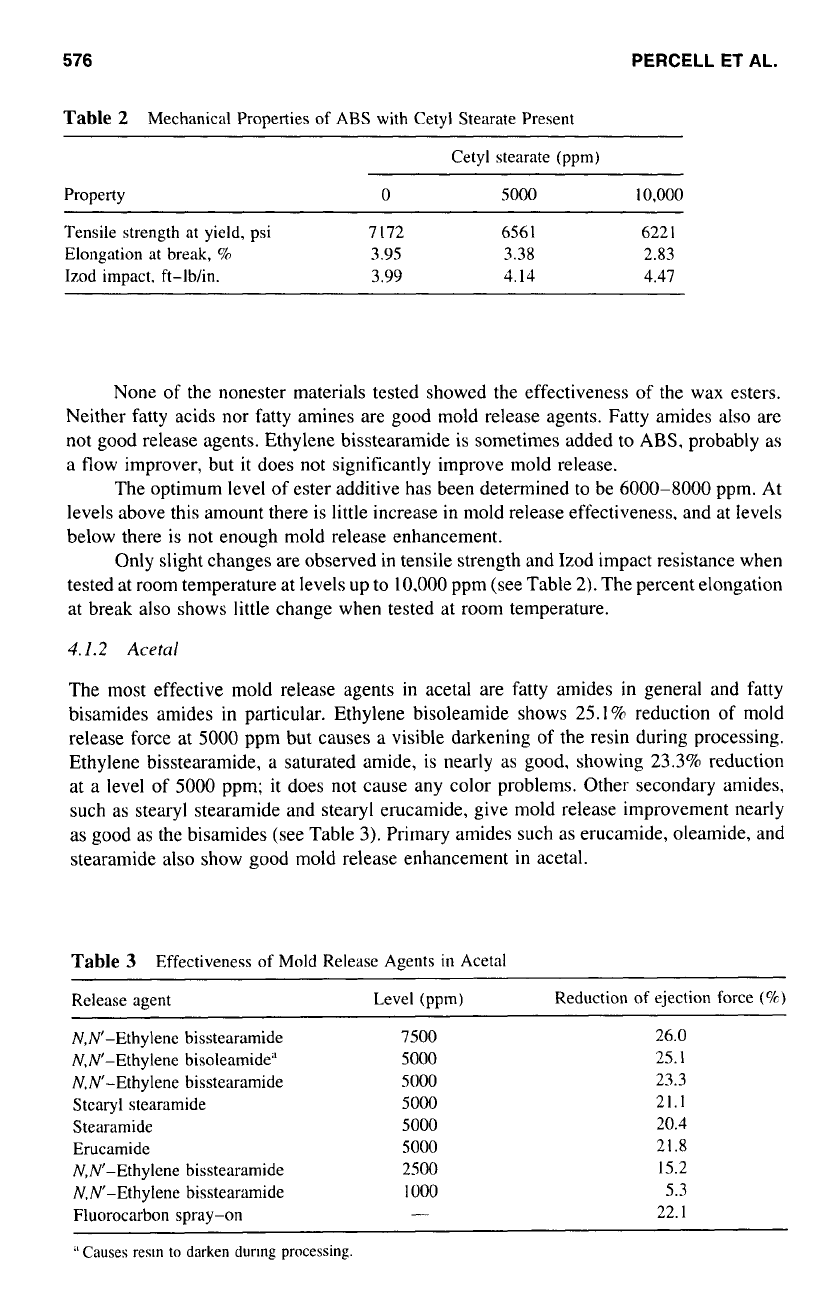
576
PERCELL
ET
AL.
Table
2
Mechanical Properties of ABS with Cetyl Stearate Present
Cetyl stearate (pprn)
Property
0
5000
10,000
Tensile strength at yield, psi
7
172 656
1
622
I
Elongation at break,
c/o
3.95 3.38 2.83
Izod
impact, ft-lb/in.
3.99
4.14
4.47
None of the nonester materials tested showed the effectiveness of the wax esters.
Neither fatty acids nor fatty amines are good mold release agents. Fatty amides also are
not good release agents. Ethylene bisstearamide is sometimes added to
ABS,
probably
as
a flow improver, but it does
not
significantly improve mold release.
The optimum level of ester additive has been determined to be
6000-8000
ppm. At
levels above this amount there is little increase in mold release effectiveness, and at levels
below there is not enough mold release enhancement.
Only slight changes are observed in tensile strength and Izod impact resistance when
tested at room temperature at levels up to
10,000
ppm (see Table 2). The percent elongation
at break also shows little change when tested at room temperature.
4.1.2
Acetal
The most effective mold release agents
in
acetal are fatty amides in general and fatty
bisamides amides in particular. Ethylene bisoleamide shows 25.1% reduction of mold
release force at
5000
ppm but causes a visible darkening of the resin during processing.
Ethylene bisstearamide, a saturated amide, is nearly as good, showing 23.3% reduction
at a level of
5000
ppm; it does not cause any color problems. Other secondary amides,
such as stearyl stearamide and stearyl erucamide, give mold release improvement nearly
as good as the bisamides (see Table
3).
Primary amides such as erucamide, oleamide, and
stearamide also
show
good mold release enhancement
in
acetal.
Table
3
Effectiveness
of
Mold Release Agents in Acetal
Release agent Level (ppm) Reduction of ejection force
(%)
N,N'-Ethylene bisstearamide
7500 26.0
N,N'-Ethylenc bisoleamide"
5000
25.1
N,N'-Ethylene bisstearamide
5000 23.3
Stcaryl stearamide
5000
21.1
Stearamide
5000 20.3
Erucamide
SO00
21.8
N,K-Ethylene bisstearamide
2500 15.2
N,N'-Ethylene bisstearamide
1000
5.3
Fluorocarbon spray-on
-
22.1
''
Causes
rem
to
darken durmg processing
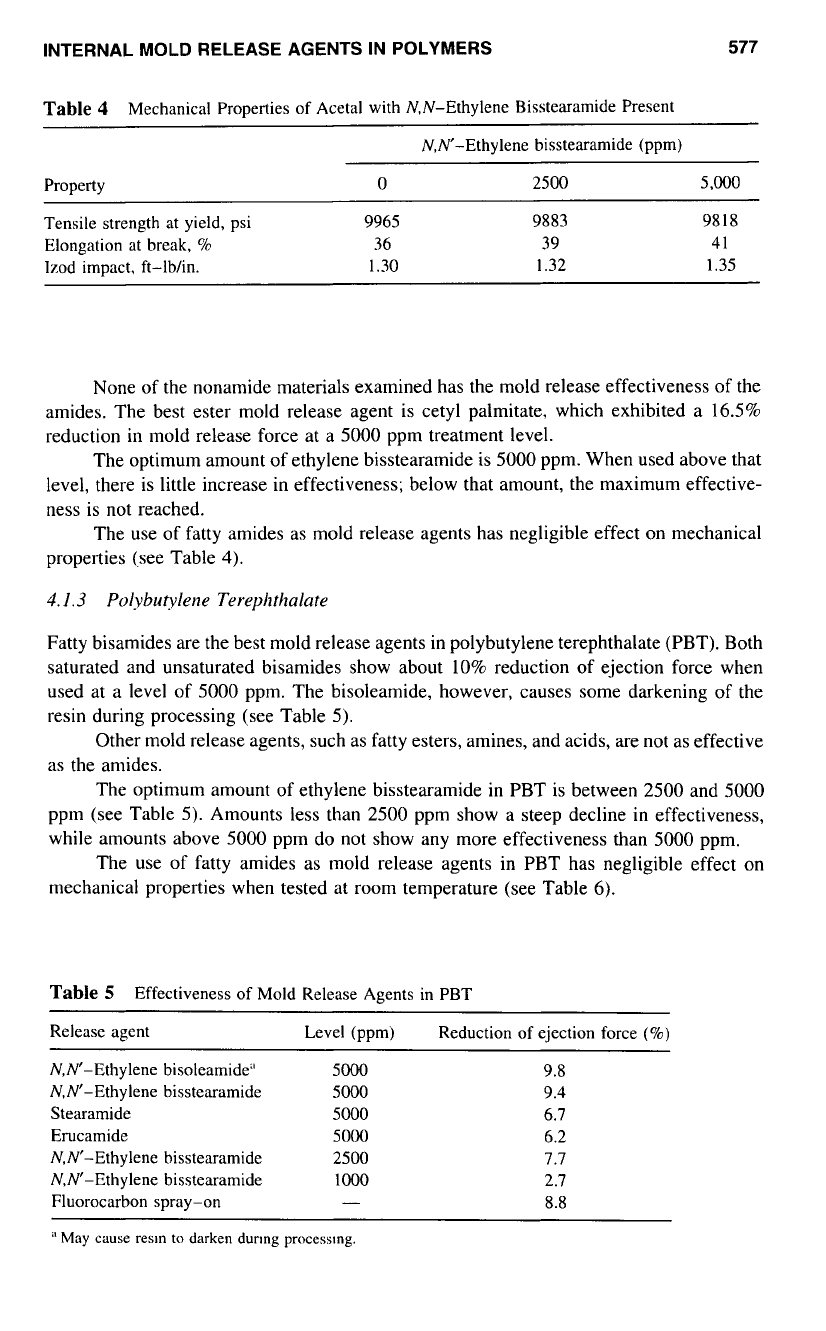
INTERNAL MOLD RELEASE AGENTS IN POLYMERS
577
Table
4
Mechanical Properties of Acetal with N,N-Ethylene Bisstearamide Present
N,K-Ethylene bisstearamide
(pp)
Property
0
2500
5,000
Tensile strength at yield, psi 9965
Elongation at break,
O/o
36
Izod impact, ft-Min. 1.30
9883
39
1.32
9818
41
1.35
None
of
the nonamide materials examined has the mold release effectiveness of the
amides. The best ester mold release agent is cetyl palmitate, which exhibited
a
16.5%
reduction in mold release force at
a
5000
ppm treatment level.
The optimum amount of ethylene bisstearamide is
5000
ppm. When used above that
level, there is little increase in effectiveness; below that amount, the maximum effective-
ness is not reached.
The use of fatty amides
as
mold release agents has negligible effect on mechanical
properties (see Table
4).
4.1.3
Pol.ybutylene
Terephthalate
Fatty bisamides are the best mold release agents in polybutylene terephthalate (PBT). Both
saturated and unsaturated bisamides show about
10%
reduction
of
ejection force when
used at
a
level
of
5000
ppm. The bisoleamide, however, causes some darkening
of
the
resin during processing (see Table
5).
Other mold release agents, such
as
fatty esters, amines, and acids, are
not
as
effective
as
the amides.
The optimum amount of ethylene bisstearamide in PBT is between
2500
and
5000
pprn (see Table
5).
Amounts less than
2500
pprn show
a
steep decline in effectiveness,
while amounts above
5000
ppm do not show any more effectiveness than
5000
ppm.
The use
of
fatty amides
as
mold release agents in PBT has negligible effect on
mechanical properties when tested at room temperature (see Table
6).
Table
5
Effectiveness of Mold Release Agents in PBT
Release agent Level
(ppm)
Reduction
of
ejection force
(%)
N,N'-Ethylene bisoleamide"
5000
N,N'-Ethylene bisstearamide
5000
Stearamide
5000
Erucamide
5000
N,N'-Ethylene bisstearamide 2500
N,K-Ethylene bisstearamide
1000
Fluorocarbon spray-on
-
9.8
9.4
6.1
6.2
7.7
2.1
8.8
'l
May
cause
rem
to
darken durlng processmg
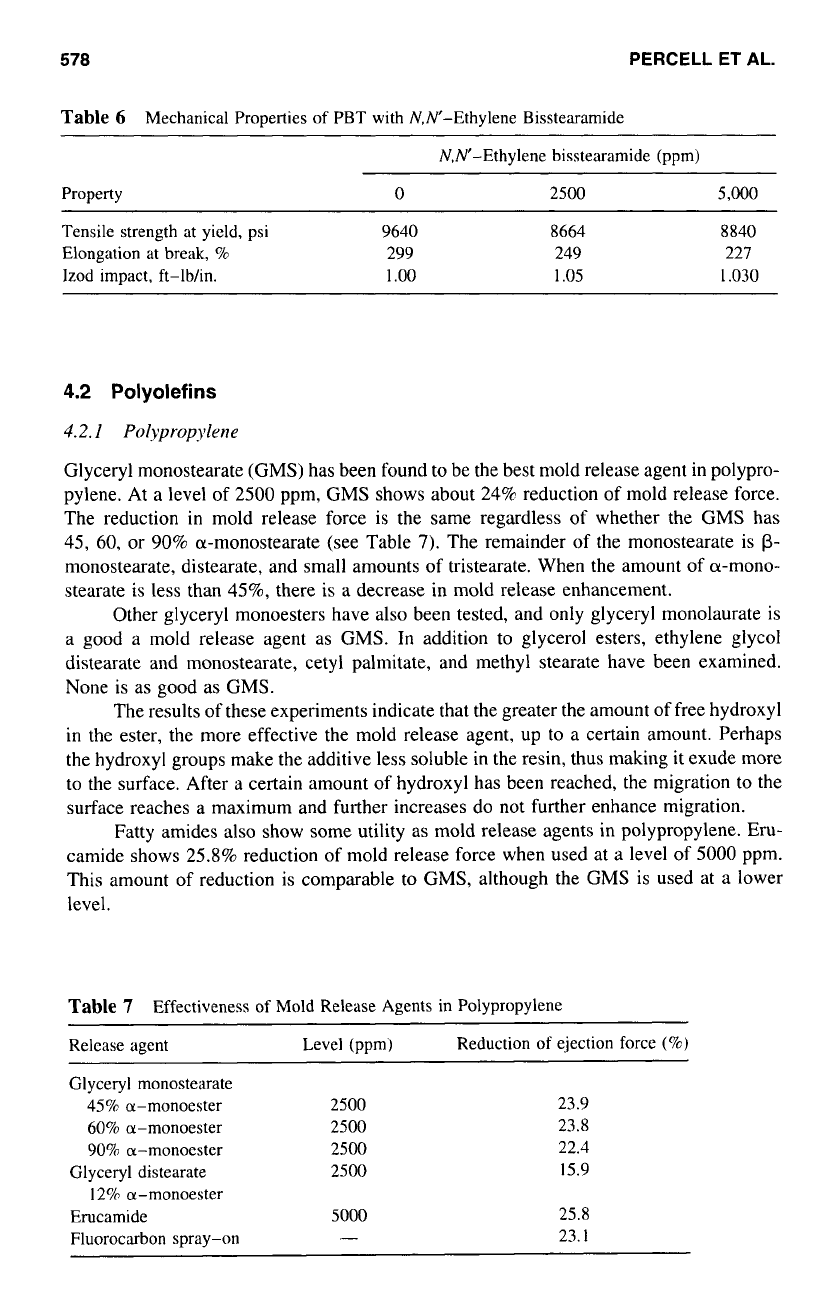
578
PERCELL ET AL.
Table
6
Mechanical Properties of PBT with N,K-Ethylene Bisstearamide
N,K-Ethylene bisstearamide (ppm)
Property
~
0 2500 5
,000
Tensile strength
at
yield, psi
9640 8664
8
840
Elongation at break,
%
299 249 221
Izod impact, ft-lb/in.
1
.oo
1.05 1.030
4.2 Polyolefins
4.2.
l
Polypropylene
Glyceryl monostearate (GMS) has been found to be the best mold release agent in polypro-
pylene. At
a
level of
2500
ppm, GMS shows about
24%
reduction
of
mold release force.
The reduction in mold release force is the same regardless
of
whether the GMS has
45,
60,
or
90%
a-monostearate (see Table
7).
The remainder of the monostearate is
p-
monostearate, distearate, and small amounts of tristearate. When the amount of a-mono-
stearate is less than
45%,
there is
a
decrease in mold release enhancement.
Other glyceryl monoesters have
also
been tested, and only glyceryl monolaurate
is
a
good
a
mold release agent
as
GMS. In addition to glycerol esters, ethylene glycol
distearate and monostearate, cetyl palmitate, and methyl stearate have been examined.
None is
as
good
as
GMS.
The results
of
these experiments indicate that the greater the amount of free hydroxyl
in the ester, the more effective the mold release agent, up to
a
certain amount. Perhaps
the hydroxyl groups make the additive less soluble in the resin, thus making it exude more
to the surface. After
a
certain amount of hydroxyl has been reached, the migration
to
the
surface reaches
a
maximum and further increases do not further enhance migration.
Fatty amides also show some utility
as
mold release agents in polypropylene.
Eru-
camide shows
25.8%
reduction of mold release force when used at
a
level of
5000
ppm.
This amount of reduction is comparable
to
GMS, although the GMS is used at
a
lower
level.
Table
7
Effectiveness of Mold Release Agents in Polypropylene
Relcase agent Level (ppm) Reduction
of
ejection force
(70)
Glyceryl monostearate
45%
a-monoester
2500
60%
a-monoester
2500
90%
a-monoester
2500
Glyceryl distearate
2500
Erucamide
5000
12%
a-monoester
23.9
23.8
22.4
15.9
25.8
Fluorocarbon spray-on
-
23.1
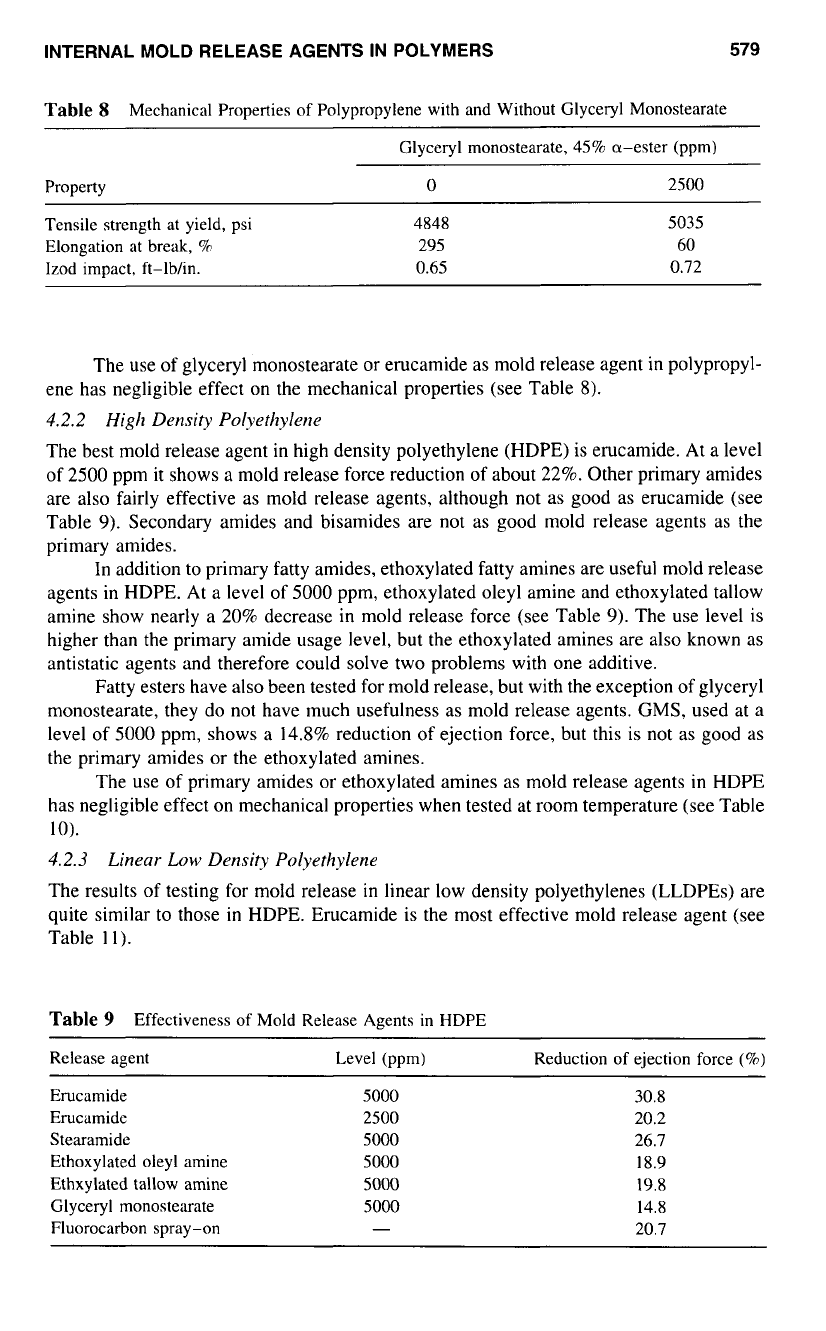
INTERNAL MOLD RELEASE AGENTS IN POLYMERS
579
Table
8
Mechanical Properties of Polypropylene with and Without Glyceryl Monostearate
Glyceryl monostearate, 45% a-ester (ppm)
Property
0
2500
Tensile strength at yield, psi
4848
5035
Elongation at break,
7O
295
60
Izod impact, ft-lbhn.
0.65 0.72
The use
of
glyceryl monostearate
or
erucamide
as
mold release agent in polypropyl-
ene has negligible effect on the mechanical properties (see Table
8).
4.2.2
High Density Polyethylene
The best mold release agent in high density polyethylene (HDPE) is erucamide. At a level
of 2500 ppm it shows a mold release force reduction of about 22%. Other primary amides
are also fairly effective as mold release agents, although not
as
good as erucamide (see
Table
9).
Secondary amides and bisamides are not as good mold release agents
as
the
primary amides.
In addition to primary fatty amides, ethoxylated fatty amines are useful mold release
agents in HDPE. At a level of
5000
ppm, ethoxylated oleyl amine and ethoxylated tallow
amine show nearly
a
20% decrease in mold release force (see Table
9).
The use level is
higher than the primary amide usage level, but the ethoxylated amines are also known
as
antistatic agents and therefore could solve two problems with one additive.
Fatty esters have also been tested for mold release, but with the exception
of
glyceryl
monostearate, they do not have much usefulness as mold release agents.
GMS,
used at
a
level of
5000
ppm, shows a
14.8%
reduction
of
ejection force, but this is not as good as
the primary amides or the ethoxylated amines.
The use of primary amides
or
ethoxylated amines
as
mold release agents in HDPE
has negligible effect
on
mechanical properties when tested at room temperature (see Table
10).
4.2.3
Linear Low Density Polyethylene
The results
of
testing for mold release in linear low density polyethylenes (LLDPEs) are
quite similar to those in HDPE. Erucamide is the most effective mold release agent (see
Table
11).
Table
9
Effectiveness of Mold Release Agents in HDPE
Release agent Level (ppm) Reduction of ejection force
(70)
Erucamide
Erucamide
Stearamide
Ethoxylated oleyl amine
Ethxylated
tallow
amine
Glyceryl monostearate
Fluorocarbon spray-on
5000
2500
5000
5000
5000
5000
30.8
20.2
26.7
18.9
19.8
14.8
20.7
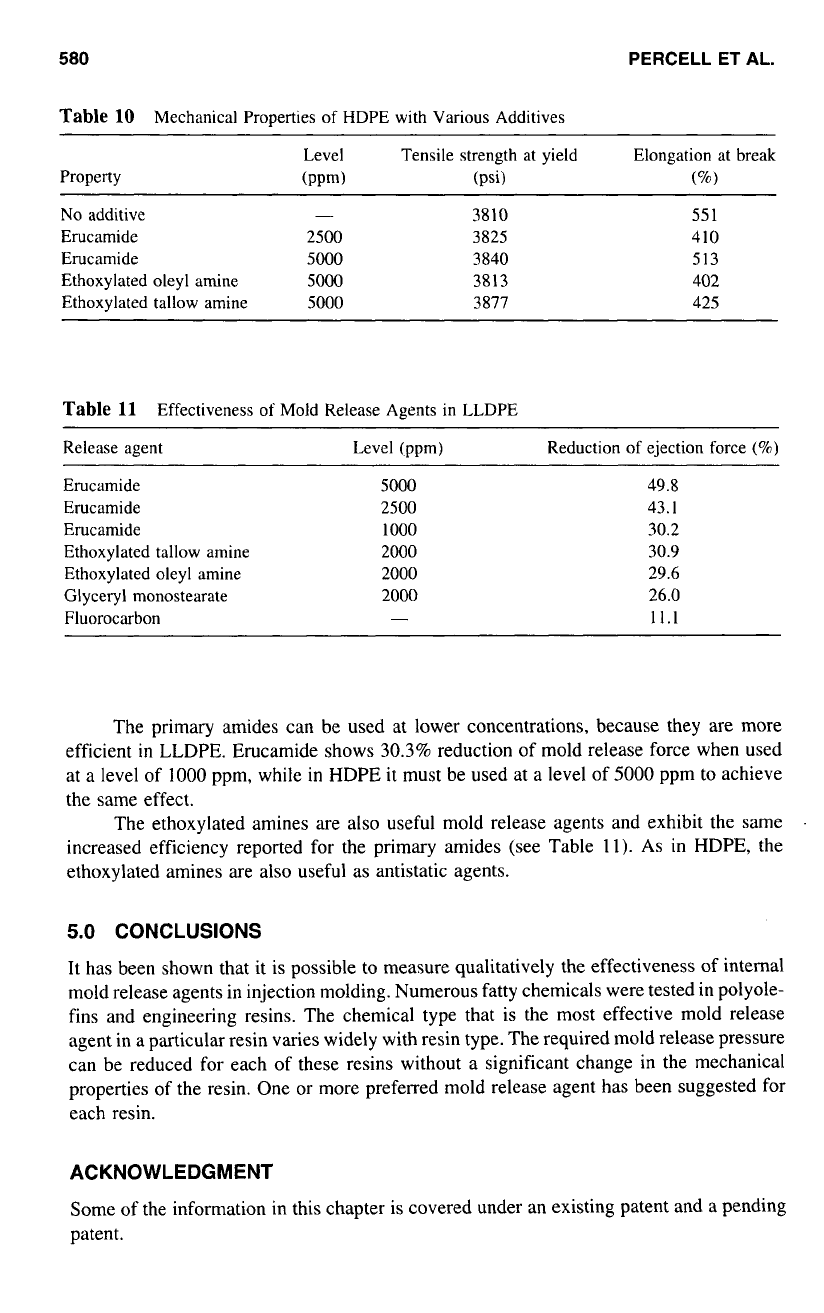
580
PERCELL
ET
AL.
Table
10
Mechanical Properties of HDPE with Various Additives
Property
Level Tensile strength at yield Elongation at break
(PP)
(psi)
(c/o)
No
additive
-
Erucamide
2500
Erucamide
SO00
Ethoxylated oleyl amine
SO00
Ethoxylated tallow amine
5000
3810
3825
3840
3813
3877
5s
1
410
513
402
425
Table
11
Effectiveness
of
Mold Release Agents in LLDPE
Release agent Level (ppm) Reduction of ejection force
(YO)
Erucamide
Erucamide
Erucamide
Ethoxylated tallow amine
Ethoxylated oleyl amine
Glyceryl monostearate
Fluorocarbon
SO00
2500
1000
2000
2000
2000
-
49.8
43.1
30.2
30.9
29.6
26.0
11.1
The primary amides can be used at lower concentrations, because they are more
efficient in LLDPE. Erucamide shows
30.3%
reduction of mold release force when used
at a level of
1000
ppm, while in HDPE it must be used at a level of
5000
ppm to achieve
the same effect.
increased efficiency reported for the primary amides (see Table
11).
As
in HDPE, the
ethoxylated amines are also useful as antistatic agents.
The ethoxylated amines are also useful mold release agents and exhibit the same
.
5.0
CONCLUSIONS
It has been shown that it is possible to measure qualitatively the effectiveness
of
internal
mold release agents in injection molding. Numerous fatty chemicals were tested in polyole-
fins and engineering resins. The chemical type that is the most effective mold release
agent in a particular resin varies widely with resin type. The required mold release pressure
can be reduced for each of these resins without a significant change in the mechanical
properties
of
the resin. One or more preferred mold release agent has been suggested for
each resin.
ACKNOWLEDGMENT
Some of the information in this chapter is covered under an existing patent and a pending
patent.
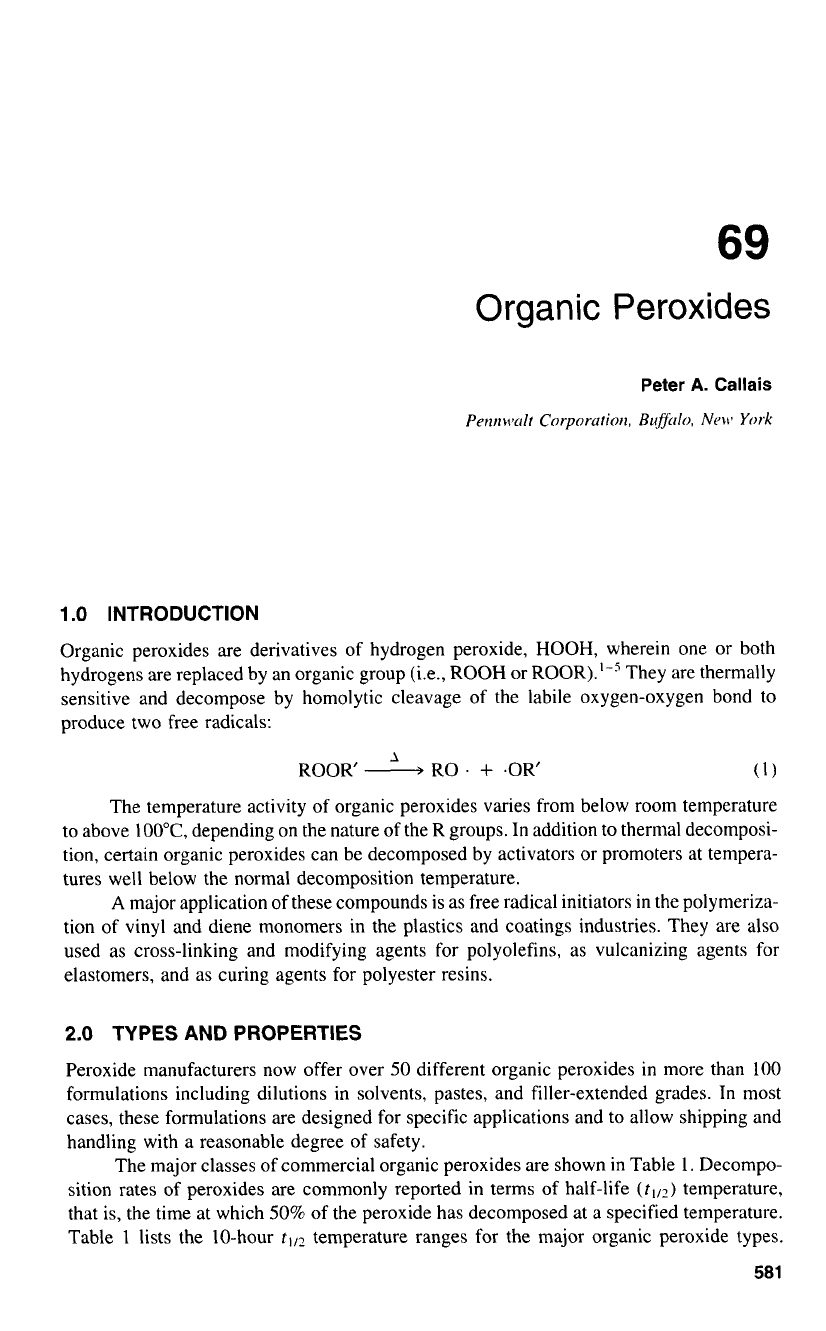
Organic Peroxides
1
.O
INTRODUCTION
Organic peroxides are derivatives of hydrogen peroxide,
HOOH,
wherein one or both
hydrogens are replaced by an organic group (i.e.,
ROOH
or
ROOR)."'
They are thermally
sensitive and decompose by homolytic cleavage of the labile oxygen-oxygen bond to
produce two free radicals:
.l
ROOR'
-
R0
.
+
.OR'
(1)
The temperature activity of organic peroxides varies from below room temperature
to above
IOO'C,
depending on the nature
of
the
R
groups. In addition to thermal decomposi-
tion, certain organic peroxides can be decomposed by activators or promoters at tempera-
tures well below the normal decomposition temperature.
A
major application of these compounds is as free radical initiators in the polymeriza-
tion
of
vinyl and diene monomers in the plastics and coatings industries. They are also
used as cross-linking and modifying agents for polyolefins, as vulcanizing agents for
elastomers, and as curing agents for polyester resins.
2.0
TYPES AND PROPERTIES
Peroxide manufacturers now offer over
50
different organic peroxides in more than
100
formulations including dilutions in solvents, pastes, and filler-extended grades. In most
cases, these formulations are designed for specific applications and to allow shipping and
handling with a reasonable degree
of
safety.
The major classes of commercial organic peroxides are shown
in
Table
1.
Decompo-
sition rates of peroxides are commonly reported in terms of half-life
(f1/2)
temperature,
that is, the time at which
50%
of the peroxide has decomposed at a specified temperature.
Table
l
lists the IO-hour
tIl2
temperature ranges
for
the major organic peroxide types.
581
